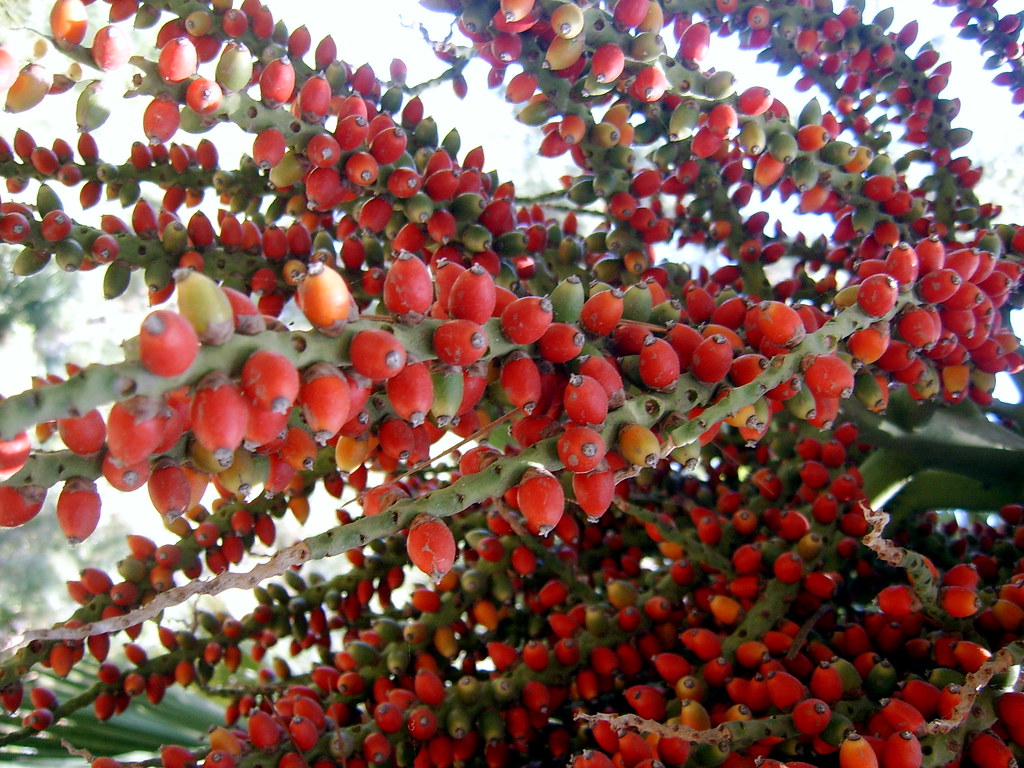Palm trees serve diverse purposes globally. Their fruits, like coconuts and dates, provide nutrition, while palm oil extracted from their kernels is a key cooking ingredient. The leaves are used for thatching and weaving, creating items such as baskets and mats.
Palm wood is employed in construction and crafting. Additionally, palm fronds serve as symbolic elements in ceremonies and events, and some species are ornamental, enhancing landscapes. The versatility of palm trees makes them invaluable in various cultural, economic, and practical contexts.
Today, we delve into the fascinating world of palm trees and showcase ten remarkable uses that go beyond their aesthetic appeal. From culinary delights and traditional handicrafts to sustainable construction materials and natural remedies, get ready to discover the stunning array of ways palm trees enrich our lives and contribute to a sustainable future. Let’s dive in!
Top 10 Uses of Palm Trees
The top 10 uses of palm trees are:
- Food: Palm trees provide various edible products. The fruits of certain palm trees, such as dates and coconuts, are widely consumed and used in cooking. Palm tree oil, extracted from the fruit, is also used for culinary purposes.
- Shelter: Palm trees have long been used as a source of shelter. The leaves of palm trees are used for thatching roofs, making temporary shelters, and constructing huts in many cultures.
- Construction material: The trunk of palm trees is strong and sturdy, making it suitable for construction purposes. It can be used for building houses, bridges, fences, and furniture.
- Fuel: Palm trees provide a source of fuel. The wood from some palm tree species is used as firewood for cooking and heating.
- Medicine: Palm trees have medicinal uses. The oil derived from certain palm tree fruits, like the oil from the African oil palm, has been used in traditional medicine for its anti-inflammatory, antimicrobial, and antioxidant properties.
- Aesthetic value: Palm trees are valued for their beauty and are commonly used as ornamental plants in gardens, parks, and landscapes.
- Landscaping: Palm trees are often planted for landscaping purposes. They add a tropical and exotic touch to gardens, parks, and urban landscapes.
- Handicrafts: Various parts of palm trees, such as leaves and stems, are used in traditional handicrafts. They can be woven into baskets, mats, hats, fans, and other decorative items.
- Environmental benefits: Palm trees contribute to the environment in several ways. They help in soil erosion control, provide shade and cool the surroundings, and act as carbon sinks, absorbing carbon dioxide from the atmosphere.
- Cultural and ceremonial significance: Palm trees hold cultural and ceremonial importance in many societies. They are symbols of good luck, prosperity, and paradise in certain cultures and are used in religious rituals and ceremonies.
These are just some of the many versatile uses of palm trees, highlighting their significance and value in different aspects of human life.
What are the Uses of Palm Leaves?
Palm leaves are used in a variety of ways, including as food wrappers, plates and bowls, umbrellas, fans, and roofs. In many cultures, palm leaves are also used for ceremonial purposes, such as in weddings or funerals.
Which Part of Palm Tree is Useful?
The palm tree is a versatile plant that has many uses. The leaves, trunk, fruit, and even roots can be used for different purposes. The leaves are used for thatching roofs, and making baskets, and mats.
The trunks are used for construction material and fuel wood. The fruits are eaten fresh or made into wine. The oil from the fruit is also used for cooking and cosmetics.
The roots are used as medicine or chewed as a hunger suppressant.
Why are Palms Important?
Palms are an important part of the landscape in many parts of the world. They can provide food, shelter, and even medicine. In some cultures, palms are also symbols of good luck or spiritual power.
Medicinal Uses of Palm Tree
Most people think of palm trees as being used for ornamental purposes or to provide shade. However, did you know that palm trees have a long history of medicinal use? The oil from the fruit of certain palm trees has been used in traditional medicine for centuries.
Palm tree oil is said to have anti-inflammatory, antimicrobial, and antioxidant properties. It’s also been used to treat skin conditions like psoriasis and eczema. Recent studies have shown that palm tree oil can be effective in treating various types of cancer.
This brief article explores ten notable medicinal uses of palm trees.
- Palm Leaf Extracts for High Blood Pressure:
Research suggests that palm leaf extracts, such as those from the Arecaceae family, may help regulate blood pressure levels. These extracts contain bioactive compounds that possess vasodilatory properties, potentially reducing hypertension risks. - Palm Oil for Antioxidant Effects:
Rich in tocopherols and carotenoids, palm oil exhibits potent antioxidant effects. These compounds are believed to help protect cells from oxidative damage caused by free radicals, reducing the risk of chronic diseases. - Palm Fruits as a Natural Source of Energy:
Palm fruits, such as dates and coconuts, are renowned for their high-calorie content and quick energy release. They provide a healthy source of carbohydrates, dietary fiber, and essential nutrients, making them an ideal snack for instant energy replenishment. - Palm Root Extracts for Digestive Health:
Certain palm tree roots, like those of the Sabal palm, possess beneficial properties for supporting digestive health. The bioactive compounds found in these extracts have been traditionally used to alleviate constipation, minimize bloating, and promote overall gastrointestinal well-being. - Palm Leaf Poultices for Skin Inflammation:
The leaves of certain palm trees can be used to make poultices that help soothe skin inflammation and various skin conditions. They have been employed in traditional medicine to provide relief from bug bites, rashes, and minor burns. - Palm Trunk Extracts for Wound Healing:
Studies suggest that palm trunk extracts may possess wound-healing properties. When applied topically, they could potentially accelerate the healing process, reduce inflammation, and enhance the formation of healthy tissues. - Palm Oil for Cardiovascular Health:
Palm oil contains a mixture of saturated and unsaturated fatty acids, including oleic acid, which is known for its positive impact on heart health. Consuming moderate amounts of palm oil as part of a balanced diet may help maintain healthy cholesterol levels. - Palm Leaf Infusions for Kidney Health:
Infusions made from palm leaves, such as those from the saw palmetto palm, have been used traditionally to support urinary tract and kidney health. They are believed to have diuretic properties and may assist in reducing common urinary symptoms. - Palm Roots for Pain Relief:
In some traditional herbal practices, palm roots are used to alleviate pain, including headaches, joint pain, and muscle soreness. The analgesic properties attributed to these roots make them a natural remedy for managing mild to moderate pain. - Palm Tree Resins for Respiratory Health:
Resins derived from certain palm trees, such as frankincense obtained from the Boswellia species, have been traditionally used to support respiratory health. They are believed to have anti-inflammatory properties, potentially providing relief for respiratory conditions like asthma and bronchitis.
Benefits of Palm Trees at Home
Most people think of palm trees as a tropical plant that is only found in hot, humid climates. However, there are actually many different types of palm trees that can thrive in a variety of different environments. Palm trees are not only beautiful and exotic looking, but they can also provide a number of benefits for your home.
Here are some of the top benefits of having palm trees at home:
- They Can Improve Air Quality One of the main benefits of palm trees is that they can help to improve air quality. Palm trees produce oxygen and remove carbon dioxide and other pollutants from the air. This can help to create a healthier environment inside your home.
- They Can Help You Save Money on Energy Bills. Another great benefit of palm trees is that they can help you save money on your energy bills. Palm trees provide shade and can help keep your home cooler in the summer months. This can lead to lower air conditioning costs and ultimately lower energy bills each month.
- They Add Value to Your Home In addition to all of the practical benefits that palm trees offer, they also add value to your home.
5 Sentences About Palm Tree
A palm tree is a type of tree that is characterized by a single trunk and large, feather-like leaves. There are many different species of palm trees, which are found in tropical and subtropical regions around the world. Palm trees are an important source of food and shelter for many animals, and they also play a role in human cultures as symbols of paradise.
Uses of Palm Tree Leaves
Did you know that palm tree leaves can be used for a variety of purposes? Here are just a few:
- Thatched roofs – Palm leaves have been used for thatched roofs for centuries. They are durable and provide excellent protection from the elements.
- Baskets and mats – Palm leaves can be woven into baskets and mats. They make beautiful, natural-looking home decor items.
- Animal feed – In some parts of the world, palm leaves are chopped up and used as animal feed. Goats, sheep, and cows all enjoy munching on them! 4. Paper products – Palm leaves can also be used to make paper products like envelopes and cards.
Parts of Palm Tree And Their Uses
The palm tree is one of the most versatile and useful trees in the world. Every part of the palm tree can be used for something, whether it’s food, shelter, or even fuel. Here are some of the most common uses for each part of the palm tree:
- Trunk: The trunk of a palm tree is strong and sturdy, making it perfect for construction purposes. Palm trunks are often used to build houses, fences, and other structures.
- Leaves: Palm leaves are large and tough, making them ideal for roofing material. In many tropical countries, palm leaves are used to thatch roofs on homes and other buildings. Palm leaves can also be woven into baskets and mats.
- Fruit: Palm fruit is a staple food in many parts of the world. The fleshy pulp inside palm fruits is eaten fresh or cooked into dishes like soup or stew. Palm nuts can also be roasted and eaten as a snack.
- Sap: The sap from a palm tree can be boiled down to make sugar or alcohol. It can also be used as glue or resin.
Uses of Palm Fruit
The palm fruit, also known as the date palm, is a type of palm that is grown for its edible fruit. The palms are native to the Middle East and North Africa, but they have been introduced to other parts of the world, including the Americas and Australia. The fruits of the date palm are often used in cooking, and they can be dried and eaten as a snack.
The oil from the fruit can be used in cosmetics and as a cooking oil. Palm fruits are also processed into sugar, which is used in baking and as a sweetener.
Frequently Asked Questions
What are the benefits of palm trees?
Palm trees offer various benefits to the environment, ecosystems, and human populations. Biodiversity, Oxygen production, Erosion prevention, Aesthetic value, and Palm trees are often associated with tropical landscapes, beaches, and scenic locations, adding to the aesthetic appeal of natural and urban environments.
What is the importance of palm leaves?
Shelter and construction: Used for roofing in traditional dwellings.
Handicrafts and art: Woven into various beautiful and functional objects.
Religious and cultural significance: Used for writing scriptures and traditional knowledge.
Culinary uses: Used to wrap and steam food, adding flavor.
Medicinal properties: Some species have medicinal uses in traditional medicine.
What are the qualities of a palm tree?
Diverse species: Palm trees come in various sizes, shapes, and appearances.
Tropical habitat: Thrive in warm climates and tropical regions worldwide.
Strong root system: Develop deep and robust roots for stability and erosion prevention.
Resilience: Adapt well to harsh conditions, including drought and strong winds.
Aesthetically pleasing: Often associated with picturesque landscapes and beaches.
Versatile: Used for shelter, food, and various cultural and economic purposes.
What are the 4 main uses for the date palm tree?
The date palm tree serves four main purposes. First, it yields delicious and nutritious dates, a dietary staple. Second, its fronds are used for crafting traditional items. Third, date palm wood contributes to construction. Lastly, the tree plays a vital role in preventing soil erosion, showcasing its environmental significance.
Conclusion
Palm trees are not only aesthetically pleasing, but they also have many uses. Here are 10 uses for palm trees:
- They can be used as windbreaks or hedges.
- The leaves can be used for thatching roofs or making baskets and mats.
- The trunks can be used for construction purposes or carved into furniture.
- The oil from the fruits can be used for cooking or as a lubricant.
- The fruits can also be eaten fresh or made into jams and jellies.
- Palm wine is a popular alcoholic beverage made from the sap of the tree’s inflorescence stalk.
- The ashes of burnt palm leaves can be used to make soap.
- In some cultures, palm fronds are used as ceremonial items such as in Hindu weddings
- The branches are sometimes used as walking sticks
- Some palm species are used for producing biofuels, which can be a sustainable alternative to fossil fuels.





 Dr Ahsanur Rahman, PHD
Dr Ahsanur Rahman, PHD


